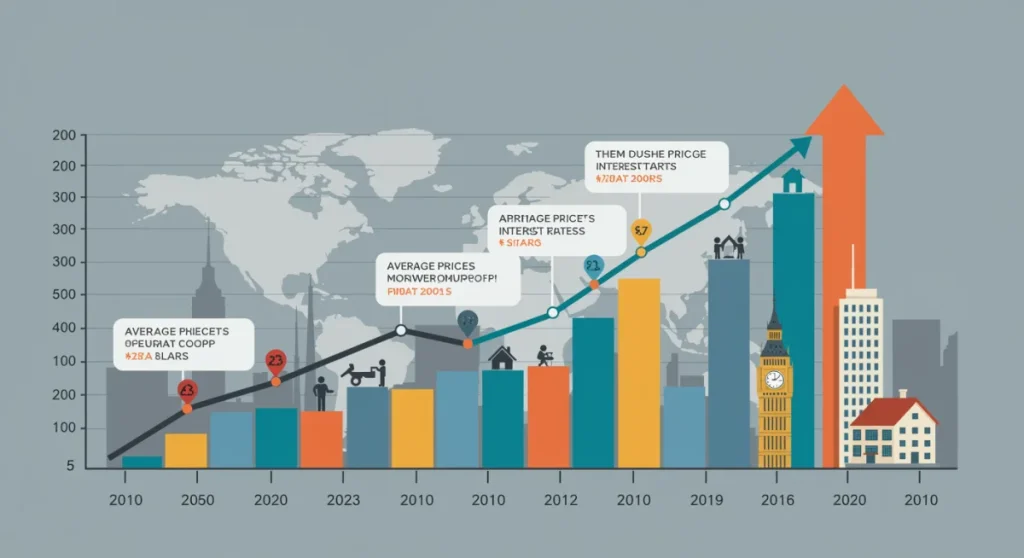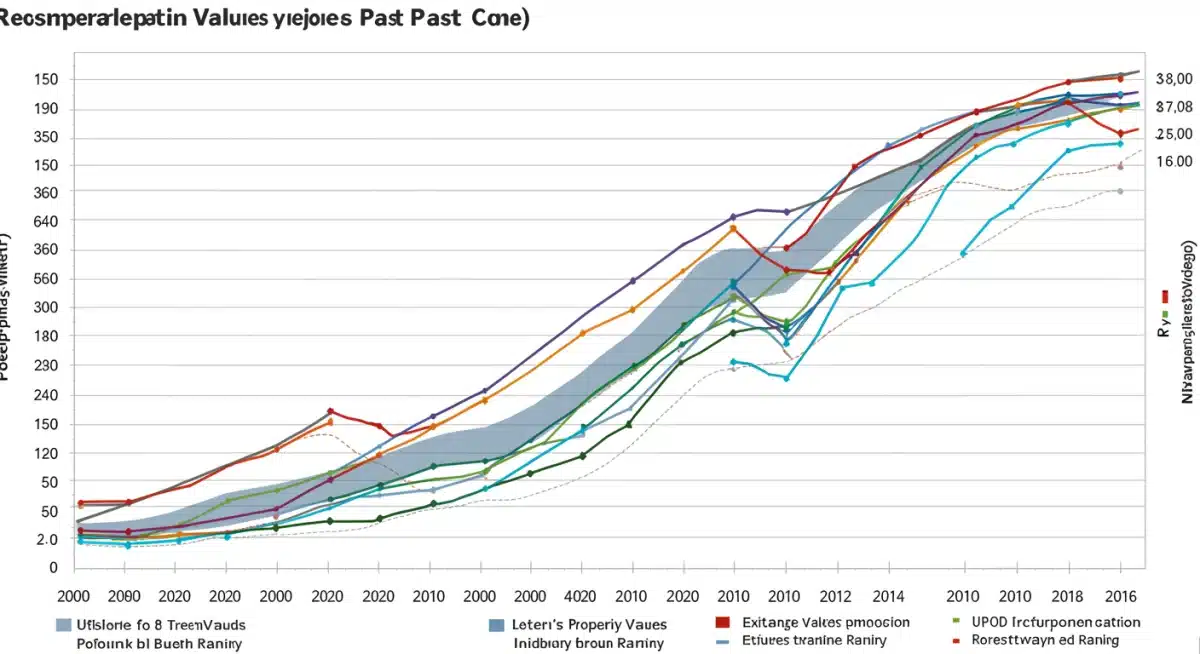Analyzing the 5-Year Trend in Real Estate Market Performance

Analyzing the 5-Year Trend in Real Estate Market Performance (COMPARISON/ANALYSIS) reveals significant shifts in housing prices, interest rates, and inventory, directly impacting both buyers and sellers across diverse regions.
As of this reporting, the global real estate sector is undergoing a profound transformation, with the last five years marking a period of unprecedented volatility and growth. This examination of Analyzing the 5-Year Trend in Real Estate Market Performance (COMPARISON/ANALYSIS) delves into the critical factors that have shaped property values, investment strategies, and housing affordability across various markets.
Understanding the Post-Pandemic Surge (2020-2021)
The initial years of our 5-year analysis, specifically 2020 and 2021, witnessed an unexpected and dramatic surge in real estate markets globally. This period, largely influenced by the COVID-19 pandemic, reshaped consumer behavior and economic policies, creating a unique environment for property values.
Lockdowns and remote work mandates spurred a strong demand for larger homes and properties in suburban and rural areas. Interest rates, slashed to historic lows by central banks to stimulate economies, made borrowing significantly cheaper, further fueling buyer enthusiasm and competition.
Shifting Buyer Demographics
The pandemic years saw a notable shift in who was buying and what they were looking for. First-time homebuyers, often leveraging low-interest rates, entered the market in droves, competing with existing homeowners seeking more space or a change of scenery.
- Increased Demand for Space: Remote work drove preferences for larger homes with dedicated office spaces.
- Suburban Migration: Many urban dwellers relocated to suburbs or exurbs for more affordable housing and outdoor access.
- Investor Activity: Low-interest rates also attracted investors, further tightening inventory.
The Interest Rate Impact and Market Slowdown (2022-2023)
Following the frenetic pace of 2020-2021, the real estate market began to rebalance in 2022 and continued into 2023. Central banks, grappling with surging inflation, initiated aggressive interest rate hikes, fundamentally altering the affordability landscape for prospective homebuyers.
This period marked a significant shift from a seller’s market to a more balanced, or even buyer-leaning, market in some regions. Higher mortgage rates directly impacted purchasing power, leading to a noticeable slowdown in sales volume and a moderation in price appreciation.
Inventory Challenges Persist
Despite the cooling demand, housing inventory remained a persistent challenge in many areas. While new listings increased from pandemic lows, they often struggled to keep pace with historical averages, preventing a steep decline in prices.
- Higher Borrowing Costs: Mortgage rates surged, making homeownership less accessible for many.
- Reduced Sales Volume: Transaction numbers decreased as buyers became more cautious.
- Price Moderation: While prices didn’t crash, the rapid appreciation seen previously largely subsided.
Regional Disparities and Emerging Hotspots
The 5-year trend analysis reveals that real estate market performance is far from uniform. While national averages provide a broad overview, significant regional disparities emerged, with some areas experiencing continued growth even amidst broader slowdowns, while others faced steeper corrections.
Tech hubs and rapidly growing employment centers often demonstrated more resilience, sustained by strong job markets and inward migration. Conversely, regions heavily reliant on specific industries or those with pre-existing affordability issues sometimes saw more pronounced market adjustments.

Factors Driving Local Markets
Local economic conditions, population shifts, and specific housing policies played crucial roles in shaping these varied outcomes. Understanding these micro-level dynamics is essential for a comprehensive view of the real estate landscape.
- Job Growth: Strong employment opportunities consistently bolster housing demand.
- Urban vs. Rural: The pandemic initially favored rural, but cities are seeing renewed interest.
- Local Regulations: Zoning laws and development policies greatly influence housing supply.
Investment Trends and Property Types
Over the past five years, investment strategies in real estate have also evolved significantly. Early in the period, individual investors and large funds targeted residential properties, driven by rising rents and appreciation potential. However, as interest rates climbed, the focus began to diversify.
Commercial real estate, particularly office spaces, faced headwinds due to remote work trends, while industrial and logistics properties thrived with the boom in e-commerce. Multifamily residential continued to attract investment, supported by strong rental demand in many urban centers.
The emphasis shifted from quick capital gains to long-term income generation, with investors carefully evaluating cap rates and operational costs in a higher-interest-rate environment. This strategic pivot reflects the changing economic realities and risk assessments within the property sector.
Affordability Crisis and Policy Responses
A central theme throughout the 5-year trend in real estate market performance has been the deepening affordability crisis. Rapid price increases, coupled with rising interest rates, pushed homeownership out of reach for many, particularly first-time buyers and lower-income households.
Governments and local authorities are increasingly pressured to address this issue through various policy interventions. These range from increasing housing supply through zoning reforms to direct subsidies and incentives for affordable housing developments.
The Challenge of Supply
The fundamental imbalance between housing supply and demand remains a critical driver of affordability concerns. Construction slowdowns, labor shortages, and rising material costs have exacerbated the problem, limiting the ability to build enough homes to meet population growth.
- Rising Home Prices: Continued appreciation makes entry into the market difficult.
- High Interest Rates: Increased mortgage costs reduce monthly affordability.
- Stagnant Wages: Wage growth often lags behind housing cost increases.
Current Market Outlook and Future Projections (2024 Onwards)
As we move into 2024, the real estate market is characterized by a continued search for equilibrium. While interest rates have stabilized somewhat, they remain elevated compared to the pandemic lows. This suggests a more subdued, but potentially healthier, market environment.
Analysts project a continued moderation in home price growth, with some regional variations. Inventory levels are expected to gradually improve, offering more choices to buyers. However, strong underlying demand and demographic shifts are likely to prevent any widespread, significant price declines.
The focus for the coming years will be on sustainable growth, driven by fundamental economic factors rather than speculative fervor. Investors and homebuyers alike are adapting to a new normal where careful financial planning and a long-term perspective are paramount.
| Key Trend | Brief Description |
|---|---|
| Post-Pandemic Surge | Historic low rates and remote work fueled rapid price increases and demand (2020-2021). |
| Interest Rate Hikes | Aggressive rate increases cooled demand and moderated price growth significantly (2022-2023). |
| Regional Disparities | Market performance varied widely across different geographic areas based on local economies. |
| Affordability Crisis | High prices and elevated rates exacerbated housing affordability challenges for many. |
Frequently Asked Questions About Real Estate Trends
Interest rates have significantly influenced the market. Historically low rates in 2020-2021 spurred a buying frenzy, while subsequent aggressive hikes in 2022-2023 dramatically cooled demand and increased borrowing costs, leading to price moderation.
The post-pandemic surge was primarily driven by a confluence of factors: record-low interest rates, a sudden increase in demand for larger homes due to remote work, and limited housing inventory, all contributing to rapid price escalation.
No, regional real estate markets are not performing uniformly. Our analysis shows significant disparities, with some areas experiencing continued growth, while others face corrections, largely dependent on local economic conditions, job growth, and housing supply dynamics.
Housing affordability has significantly deteriorated over the past five years. Rapid home price appreciation combined with rising interest rates has made homeownership increasingly challenging for many, particularly first-time buyers and those with moderate incomes.
The current outlook suggests a more balanced market, with moderated price growth and gradually improving inventory. While interest rates remain higher than pandemic lows, the market is adjusting, focusing on sustainable growth driven by fundamental economic factors rather than speculative activity.
What Happens Next
The coming months will be crucial for the real estate sector as it continues to navigate a complex economic landscape. Investors and homebuyers should closely monitor central bank policies, inflation trends, and regional economic data. The interplay of sustained demand, evolving work patterns, and ongoing supply challenges will dictate the pace and direction of the market. Expect continued regional variations and a discerning approach from both buyers and sellers as the market seeks a new, sustainable equilibrium.





